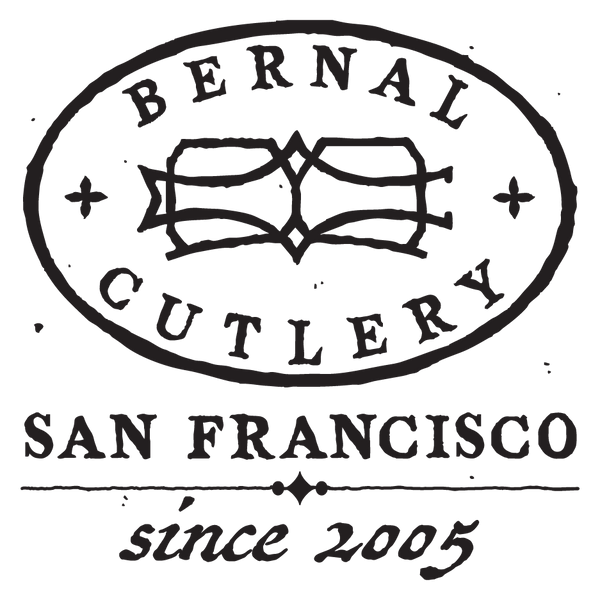My Tiny Knife Collecting Problem
February 20, 2025 – Kelly Kozak
My tiny knife Collecting Problem, an Ode to the Paring Knife
The Kitchen Culture of In-hand Knife Skills
At 5 years old, my first job was helping my Grandma Gallagher out on Sunday morning. First, I cleaned “dust bunnies” around the hardwood floor corners, and then, after that, my next and most exciting task was cutting the morning vegetables for her Sunday soup. She paid me $2 for this work, which I greatly adored. Granma Jane, a mother of eight, took a lot of pride in her Sunday soup, and I remember her telling me that the soup was how she would get her adult kids to come back home for a meal. This is where I learned my most basic knife skill set and how my love of paring knives must have started. I learned how to cut a large amount of vegetable ingredients for a huge stock pot amount of soup that would feed at least 12 people and include some to take home in a recycled food container, I mostly remember a lot of “I can’t believe it’s not butter” and cottage cheese containers. Half of her eight kids were out of the house but would come by for a hot meal and maybe bring a few people with them. It was a kitchen event, and I was part of it at such a young age. I remember how proud I felt about that job. I learned not only how to cut on a board but also how to cut over a bowl or pot in my hands like she did.
Today, my knife skills resemble my dyslexic handwriting, where you will see my final product folded, stacked, and pulled together when I have time and want to focus, or if someone is watching, quick, snappy and semi-legible with hidden misspellings in the cursive but sturdy with gumption and utility; and as I have aged as a mom of three cooking for a bigger family I have added thrifty incredibly utilitarian, serviceable and flavorful to my knife skills. I cut both in hand, on a board and sometimes I cut with kitchen scissors.
Hand cutting as a knife skill is usually seen in French or French-inspired professional kitchens for careful peeling using a bird’s beak (Tournét) or the old guard folk in home-kitchens, such as grandmothers and great Aunties. Over the years, I have found myself wanting to keep this particular knife skill alive and pay it homage as much as I can, especially when cooking soup. It has also led to my insane collection of tiny knives. I must have a couple dozen tiny knives in use in my kitchen, and even more, are still in my tucked-away collection. I know on the outside it might seem like I have a problem collecting these knives, but I genuinely find so much joy in each one of them, and you can, too.
Although small knives do great careful work on boards, learning to process your home produce using hand-cutting knife skills can serve as mediation and demand one to slow down and carefully consider what you are cutting. I notice that my carrots, potatoes, and cucumbers look beautiful, but I’ve also wasted a lot less than I would have with a larger knife. It’s also a skill that can carry over to a large knife. I have the ability to hand-cut produce with a large knife, although it is not really recommended unless you are strictly interested in showing off.
In one box of old knives years ago, I found a 2.75-inch French paring knife. This was the most lovely, elegant old vintage knife with the best hand-cutting feel, and although it had a life cutting before and was mid-life, there was still more life to be had in the blade. The wood handle was very old, splintered, and maybe not the most hygienic. To give some color here, Josh would try to throw the knife away as he would say it was time to “retire it”. I coveted this knife. Fun Fact: Eventually, Josh found a Thiers, France maker still making these knives, and we source them for our retail store under Au Sabot. So now I have the new version and the 80-year-old version. They are super thin, well-ground paring knives with a sleek taper in the handle. They are great for peeling hand-cut cucumbers over a salad bowl or for general utility. I also really love the thin grinds and handle of the F. Herder x Bernal Cutlery paring knife.
Paring comes from the Latin word pare, meaning to take away or peel. Although my collection has knives 6 inches and smaller, the proper pairing knives generally refer to small, narrow-shaped knives that are 4 inches and smaller.
Over time paring knives have come to us from a mashup of knives intended for general utility, eating, small butchery, as well as the obvious trimming and peeling knives for food preparation. The ‘office’ knife, a 5 or 6-inch stiff narrow utility knife used to butcher small game in the “office” room where game and produce entered a manor’s kitchen, is a main ingredient in the stiffer forged paring knives, but in the woodpile, we will find older personal knives carried for both utility and eating (the great great great grandparents of our table knives) and much smaller thinner vegetable peeling knives which peelers have generally replaced. Today, you find three main blade shapes: spear point, sheep's foot, and tournet (bird’s beak), a cousin of the traditional hook shaped bladed pocket folders as well.
So, my plea to you, dear reader, is to find yourself a small tiny workhorse that fits in your hand perfectly. Get a collection of tiny knives going, new, old carbon stainless and ranging from 2.5 to 6”, and keep them handy and give them love, and they will love you back.
